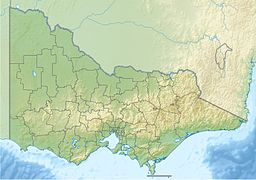Lake Batyo Catyo is a human-made freshwater lake located 26 km west of the town of St Arnaud in North Central Victoria, Australia. It is now dry, as the inflow channel from the Richardson River was permanently closed in 2012.
| Lake Batyo Catyo | |
|---|---|
| Location | North Central Victoria |
| Coordinates | 36°30′54″S 142°56′21″E / 36.51500°S 142.93917°E |
| Type | reservoir |
| Primary inflows | Souths Creek, Richardson River |
| Primary outflows | Donald Channel |
| Basin countries | Australia |
| Surface area | 2.3 km2 (0.89 sq mi) |
| Average depth | 2.5 m (8 ft 2 in) |
| Settlements | St Arnaud, Donald |
The lake surface covered 230 hectares to an average depth of 2.5 metres.[1] It is the terminus for water flowing from the Richardson River via Souths Creek and three smaller reservoirs to its southwest.
History
editThe lake was constructed in 1961 as an irrigation reservoir for dairying and for cereal crops.[1] Water was diverted from the Richardson River during high-flow periods to create a reservoir holding an average of 1,130 ML and a maximum of 2,250 ML. The lake was used for waterskiing and other recreational and tourist activities based in the nearby towns of Donald and St. Arnaud.
However, in 2010 the Wimmera Mallee Pipeline was completed, meaning water storage at Batyo Catyo was no longer necessary. In 2012, Richardson River diversion rules were changed so water no longer flowed into Batyo Catyo, and the inflow from Rich Avon Weir was permanently closed.
In 2020, local communities began campaigning to restore water to Lake Batyo Catyo for recreational purposes.[2]
Fauna
editNow dry, the lake was home to communities of Murray cod, golden perch and redfin perch,[3][4] though fish habitat can be affected by drought conditions.[5]
Flora
editNative flora include species common to grassy wetlands. The shoreline is dominated by River Red Gum (Eucalyptus camaldulensis) associated with Canegrass (Eragrostis infecunda) Tangled Lignum (Muehlenbeckia florulenta) and spiny sedge (Cyperus gymnocaulus).[6] The southern and southwestern shore is also home to stands of Black Box (Eucalyptus largiflorens) Three threatened species are present: the Pale Spike sedge (Eleocharis pallens), Chariot Wheels (Maireana cheeli) and Turnip Copperbur (Sclerolaena napiformis).[6] Upstream land clearing in the 1960s has increased salinity levels in the lake, but a 2006 water quality study indicated sufficient fresh water to maintain existing vegetation.[6]
References
edit- ^ a b "Major reservoirs not required following completion of the Wimmera Mallee pipeline" (PDF). GWM Water. September 2007. Archived from the original (PDF) on 29 August 2007. Retrieved 8 January 2008.
- ^ Steel, Russell (27 November 2020). "Batyo Catyo Plan". The Buloke Times. Retrieved 2 October 2022.
- ^ "Inland Fish Habitat Protection Extended". Fish Victoria. April 2004. Retrieved 8 January 2008.
- ^ "Protecting Fish habitat during Drought". Sportsfish Australia. February 2003. Retrieved 8 January 2008.
- ^ "Fisheries (Inland Fish Habitat) Notice 2006" (PDF). Department of Primary Industries, Victoria. May 2006. Archived from the original (PDF) on 29 August 2007. Retrieved 8 January 2008.
- ^ a b c "Avon Plains Lakes Water Management Plan". Sinclair Knight Merz. February 2006. Archived from the original on 23 July 2008. Retrieved 8 January 2008.
